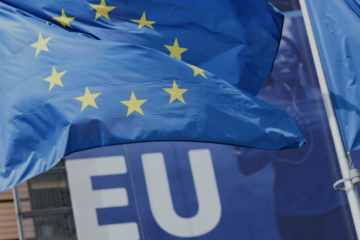AUTHOR: ALBA PATOZI, LSE 3RD YEAR BSC ECONOMICS
Four months after the referendum to leave the European Union, Britain finds itself in turmoil and uncertainty. The latest figures show that the pound has fallen dramatically to levels not seen since 1985. Economic growth remains sluggish and the construction sector experienced a decline of 1% in the last 3 months.
But perhaps the sector that is hurting the most is the trade sector, which has been subject to inflationary pressures. Since the UK is a net importer, these inflationary pressures are likely to deepen the current account deficit.
This article will focus on this particular issue, aiming to shed some light on Britain’s trade policies in a post-referendum world.
There are four possible scenarios that could be on Britain’s economic agenda that follows invoking article 50.
- Britain could decide to be a member of the European Economic Area (EEA) as in the case of Norway.
- Britain could decide to sign bilateral treaties with the EU as in the Swiss model.
- Britain could re-join the European Free Trade Association (EFTA), which it founded in 1960.
- And lastly, it could choose to comply with WTO MFN’s (Most Favourite Nation) tariffs and negotiate its own FTA with other non-EU countries.
EEA – A lesson from Norway
If Britain joins the EEA, then it will have access to the single market. This single market will guarantee Britain the four freedoms of the European Union, which are the freedom of movement of goods, services, people and capital across the borders. In addition, as a non-EU member, Britain is free to negotiate trade deals with other countries independently of the EU.
However, these advantages come at a cost of having to contribute as much as 83% of its current payments to the EU’s development funds and programmes.
Therefore, Dr. Swati Dhingra at LSE argues that becoming part of the EEA will not generate substantial fiscal savings (0.09% of national income) for the UK government.
Another drawback is that Britain would be required to implement EU policies, but have no say in setting or negotiating these policies.
Bilateral treaties- A lesson from Switzerland
By signing bilateral treaties with the EU, Britain would be negotiating to participate in a series of EU policies and programmes.
Drawing from Switzerland’s example, these bilateral treaties have secured free trade in goods, while also including technical non-tariff barriers to trade. However, they do not cover the service sector. This would be particularly damaging for a service-driven economy as the UK, where services contribute to around 93% of the GDP.
Again, the free movement in goods, capital and people comes at a cost of around 40% of what the UK currently pays to the EU budget.
Dr. Thomas Sampson at LSE argues that overall it’s likely that the Swiss model will result in less economic integration between the UK and EU than the EEA membership. Moreover, just as in the Swiss case, the UK would lose bargaining power in EU trade policy negotiations.
EFTA- Moving back in time
Another alternative is to re-join the European Free Trade Association (EFTA), which will provide the UK with a FTA that covers all non-agricultural goods. It is worth mentioning that this alternative does not guarantee free movement of labour and services. As argued previously, the failure to include services will have tremendous implications on Britain’s current account deficit. On the other hand, under this scenario the UK has no obligation to contribute to the EU budget.
On a separate note, one must bear in mind that the average EU tariffs today stand at very low levels (1%) and perhaps are not the most significant barriers to trade. Other indirect non-tariff barriers such as complying with the rules of origin, anti-dumping measures and product standards are argued to be the real costs of trade.
As re-joining EFTA does not lift these non-tariff barriers, policy makers must be very cautious when analysing the advantages of this scenario.
WTO- Most Favourite Nation tariffs, but least favourite option
Assuming that the UK chooses not to follow any of the proposed trade deals, the only remaining option would be to comply with World Trade Organisation rules and set MFN tariffs to all other WTO member countries. Of course, this option does not restrict the UK to seek economic integration with other non-EU economies. In fact politicians have proposed that the UK must increase its economic cooperation with the Commonwealth countries. However, as a very simple trade gravity model would suggest, trade flows disproportionately with distance. Therefore it becomes easier for the UK to trade with large-size neighbouring economies such as the EU.
What should be done – a proposal
Finally a study by the Centre for European Reform argues that Britain’s economic interest lies in reducing both the direct and the indirect costs of trade with its largest trading partners, such as the EU. Their model also shows that such economic integration with the EU also boosts investments and Foreign Direct Investments inflows. The service sector in Britain is the recipient of 60% of FDI from the EU over the last decade. The failure to incorporate services in the future trade deal would be catastrophic for exports, investments and economic growth. Therefore this article advises policy makers to seek a trade plan (such as the Norway model) that includes services, enhances competition and triggers FDI inflows.
The Trade Gravity Model:
One of the oldest models in international trade is the so-called gravity model.
The name was inspired from Newton’s Law of universal gravitation between two particles i and j. In international trade, instead of particles the model describes the trade flow relationship between two countries i and j.
Tij=GYiYj/Dij
Where
- Tij= Is the trade flow between country i and j
- Yi= national output of country i
- Yj=national output of country j
- G=gravitational constant
This equation suggests that trade between two countries flows proportionately with economy sizes and inversely proportional with the distance between two countries. Distance matters in international trade because it increases transportation costs, freight carrier costs, marine insurance costs, time and communication costs.


